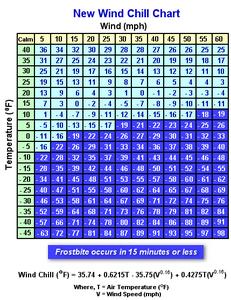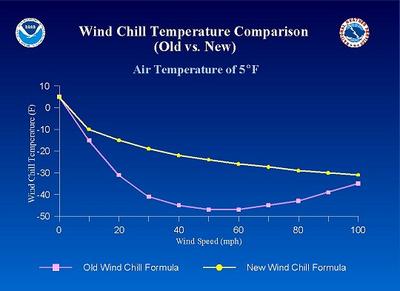
|
19 November, 2002The Wind Chill Debate Date: 11/19/02 Time of Log: 9 PM local time Latitude: 77 degrees 51 minutes South Longitude: 166 degrees 40 minutes East Temperature: -09 C / +16 F Wind speed: 13 knots Wind Chill "Old formula": -24 C / -10 F Wind direction: Northeast Meters of ice collected: 0 Logbook notes ? We are still here in McMurdo ? waiting. The log book entries from prior days will give you an idea of how we are keeping busy while waiting and today was no different for the team. I decided to make use of my free day to look into a question that we have been pondering, "what is wind chill?". We are back on the manifest to depart tomorrow at 0900 hours. We are all anxious to get going! Antarctica is the coldest, windiest continent in the whole world. Everyone knows that! But what does that mean for the people and animals who live here? How do wind and cold combine to make this such miserable place to live and work? The combination of wind and cold create what is known as "wind chill". Wind chill is not some special kind of temperature, it is a subjective term that tells us how we will perceive the cold in a given wind condition. For example, +9°F feels more like ?18°F when the wind is blowing 55mph. This term,"wind chill" was coined by early explorer, Paul Siple and Charles Fassel in 1939. The title of his research title was "Adaptation of the Explorer to the climate of Antarctica" . He experimented with containers of water. He did this by leaving them outside to freeze at different temperatures and wind speeds. He would record how long a given quantity of water would take to freeze in the conditions and from this he derived his wind chill equations. What he found was that the higher the wind speed the faster the water would freeze in the can at a given temperature. The wind helped to remove the heat from the can, but we know that wind alone does not cool. If it did then we wouldn’t need refrigerators. There must be something, such as moisture that helps with the heat transfer. So in some ways Siple’s formulas were flawed. They only worked down to certain temperatures and windspeeds, after that point the wind chill temperature actually appears to increase, which we all know by experience is impossible. In October, 2000 the Canadians decided it was time to research a new way to calculate wind chill. So, in 2001 a new wind chill formula was derived by testing volunteers reactions to cold and wind in a climate chamber. This new formula, created by Dr.Bluestein and colleague Jack Zecher, tested humans skin temperature changes in response to changes in temperatures and wind speed variations. What they found was that the old formulas created greater wind chills (or colder temperature outcomes) than their experiments. In the graph posted below you can see the differences in the new formula and old formula’s results. wind chill calculator web site Why do we create wind chill numbers and talk about these things? Two reasons: first, it is very windy in Antarctica, and second, it is important to be aware of conditions that can make our skin freeze, better known as frostbite. Why is it so windy in Antarctica? Several factors combine to make this a very windy place. Unlike anywhere else on earth, the continent of Antarctica is surrounded by strong oceanic currents. These currents completely encircle it and help to create an enormous wind vortex circling the continent that spawns fierce storms. The intensity of these storms is due to the significant temperature and humidity gradient that occurs between the very cold continent and the relatively warm ocean that surrounds it. Cold polar air sinks at the South Pole and heads for the warmer ocean areas of lower atmospheric pressure. These winds are called Katabatic winds. Once the wind begins to blow there are very few natural windbreaks. So it is possible for the wind to build up to speeds as high as 327 km/hr (equal to 163 knots or 142mph), the highest recorded wind speed in the world. Interestingly, there are also higher elevation areas of the continent that are not very windy, but they are less common. People who work in Antarctica, unlike the penguins how live here, are not natural to this place and therefore not created to be in these cold temperatures for such long periods of time. At temperatures below ?18°F human skin will freeze in fifteen minutes. This freezing is very dangerous for us and creates a medical emergency that can require evacuation. Therefore, we must be aware of how critical the conditions are outside before venturing out to work. One easy way to see this is by looking at a wind chill chart. I have posted one below that uses the new formulas. You can see that the temperatures and wind speeds combine to create these hazardous conditions. Why then does McMurdo Station still use the old formula for wind chill calculations? I asked around McMurdo today and did not come up with a solid answer. However, my intuition is that using the formula that gives colder temperatures for the "wind chill temperature" encourages people who live and work here to be more safety conscious and dress for the cold rather than risk frostbite or hypothermia. The second reason could be that the "new formula" is only used in North America whereas the bases in Antarctica are in a more international setting. But whatever the number, wind chill is just a calculated number, what is really important are the two factors that create dangerous cold, temperature and wind speed. One quickly learns this while in Antarctica, even a five-minute walk to the cafeteria can make your ears freeze if you forget your hat on a windy day. The Penguins survive long cold winters on the ice, by huddling together in groups and by using their bodies as a wind screen. They take turns being on the inner and outer circle of the huddle so that no one penguin has to endure too many hours of cold and wind. Humans have learned from the penguins and build wind-screens around their working and living quarters. We also are now using modern wind breaking fabrics in our clothing and covering all of our exposed skin from the wind. So, I hope that this clarifies why one can find different wind chill numbers for the same temperatures and wind speeds. The new formula for winds in mph and Fahrenheit temperatures is: Wind chill temperature = 35.74 + 0.6215T - 35.75V ^(0.16) + 0.4275TV^(0.16) The old wind chill formula was: T(wc) = 0.0817(3.71V^0.5 + 5.81 -0.25V)(T - 91.4) + 91.4 T(wc) = 0.0817(3.71V^0.5 + 5.81 -0.25V)(T - 91.4) + 91.4 Source for both formulas: The National Weather Service . In the formula, V is in the wind speed in statute miles per hour, and T is the temperature in degrees Fahrenheit. Note: In the formulas, ^ means the following term is an exponent (i.e. 10^(0.5 ) means 10 to the 0.5 power, or the square root of 10), - means to subtract, + means to add. A letter next to a number means to multiply that quantity represented by the letter by the number. The standard rules of algebra apply.
Contact the TEA in the field at . If you cannot connect through your browser, copy the TEA's e-mail address in the "To:" line of your favorite e-mail package. |






